* Listening
1. Listen to a talk about three traditional festivals and their environmental impact. Number the pictures of the festivals in the order you hear.
(Nghe một bài nói chuyện về ba lễ hội truyền thống và tác động của chúng tới môi trường. Đánh số các hình ảnh về lễ hội theo thứ tự bạn nghe được.)
Bài nghe:
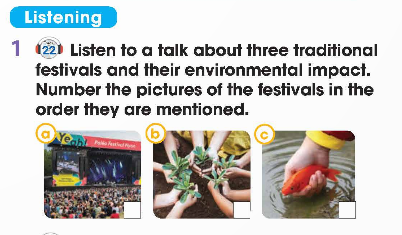 Trả lời:
Trả lời:
2. Listen again and decide whether the following sentences are true (T) or false (F).
(Nghe lại và quyết định xem những câu sau đây đúng (T) hay sai (F).)
Bài nghe
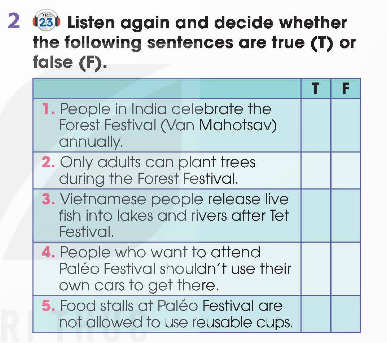 Trả lời:
Trả lời:
Speaking
1. Work in pairs. Discuss the purpose and eco-friendliness of these festivals and traditions and complete the table below.
(Làm việc theo cặp. Thảo luận về mục đích và tính thân thiện với môi trường của những lễ hội và truyền thống này và hoàn thành bảng dưới đây.)
 Trả lời:
Trả lời:
| Festivals/ Traditions |
Purpose/ Eco - friendliness |
| 1. Forest Festival (India) |
- To encourage every person in India to plant a tree
- To raise people's awareness about the importance of forests |
| 2. Fish release (Tet Festival, Viet Nam) |
- To express environmental consciousness by fostering a connection between humans and nature
- To promote the well-being of aquatic ecosystems |
| 3. Paléo Festival (Switzerland) |
- To celebrate cultural diversity through music, art, and performance
- Has implemented initiatives to minimize its environmental impact, such as promoting public transportation and encouraging the use of reusable containers |
2. Work in groups. Choose a tradition or festival in your area. Discuss ideas about how to make this tradition or festival greener.
(Làm việc theo nhóm. Chọn một truyền thống hoặc lễ hội trong khu vực của bạn. Thảo luận các ý tưởng về cách làm cho truyền thống hoặc lễ hội này trở nên xanh hơn.)
Trả lời:
- Tet in Viet Nam (Tết ở Việt Nam)
+ Encourage the use of eco-friendly materials for traditional decorations such as bamboo, recycled paper, and natural fibers.
(Khuyến khích sử dụng các vật liệu thân thiện với môi trường trong các đồ trang trí truyền thống như tre, giấy tái chế, sợi tự nhiên.)
+ Organize clean-up activities before and after Tet to ensure public spaces remain litter-free.
(Tổ chức các hoạt động dọn dẹp trước và sau Tết để đảm bảo không gian công cộng không có rác thải.)
+ Limit the use of plastic decorations and opt for reusable items that can be stored and reused.
(Hạn chế sử dụng đồ trang trí bằng nhựa và lựa chọn những vật dụng có thể tái sử dụng để bảo quản và tái sử dụng.)
* Reading
1. Read the text about Alexandre Yersin. Mark the letter A, B, C, or D to indicate the correct answer to each of the following questions.
(Đọc đoạn văn về Alexandre Yersin. Đánh dấu chữ cái A, B, C hoặc D để chỉ ra câu trả lời đúng cho mỗi câu hỏi sau.)
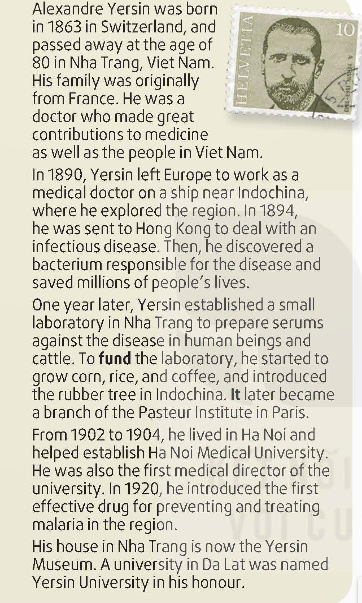
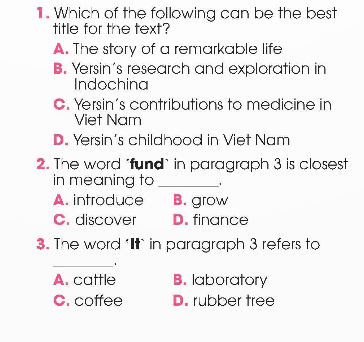
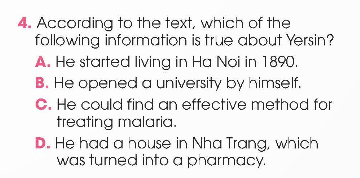 Trả lời:
Trả lời:
2. Read the following passage about Ton That Tung's contributions to the medicine in Viet Nam. Mark the letter A, B, C, or D to indicate the correct word that best fits each blank.
(Đọc đoạn văn sau đây về những đóng góp của Tôn Thất Tùng cho nền y học Việt Nam. Đánh dấu chữ cái A, B, C hoặc D để chỉ ra từ đúng phù hợp nhất với mỗi chỗ trống.)
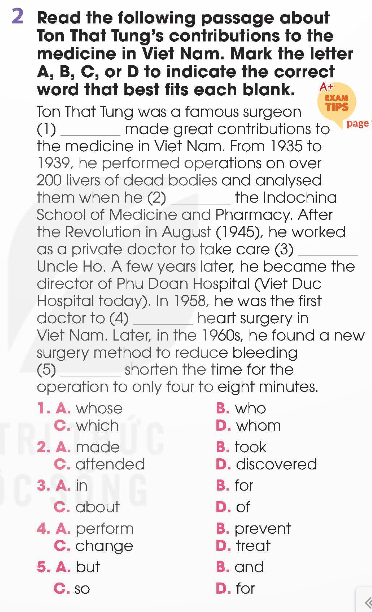 Trả lời:
Trả lời:
1. B
“made” là động từ, trước đó cần chủ ngữ chỉ người => chọn “who”.
2. C
A. made (làm)
B. took (lấy)
C. attended (tham gia)
D. discovered (khám phá)
3. D
Cụm động từ: take care of (chăm sóc)
4. A
A. perform (thực hiện)
B. prevent (ngăn chặn)
C. change (thay đổi)
D. treat (đối xử)
5. C
Từ nối: nối 2 vế tương đương nhau => dùng “and”
Ton That Tung was a famous surgeon who made great contributions to the medicine in Viet Nam. From 1935 to 1939, he performed operations on over 200 livers of dead bodies and analysed them when he attended the Indochina School of Medicine and Pharmacy. After the Revolution in August (1945), he worked as a private doctor to take care of Uncle Ho. A few years later, he became the director of Phu Doan Hospital (Viet Duc Hospital today). In 1958, he was the first doctor to perform heart surgery in Viet Nam. Later, in 1960s, he found a new surgery method to reduce bleeding and shorten the time for the operation down to only four to eight minutes.
Dịch:
Tôn Thất Tùng là một bác sĩ phẫu thuật nổi tiếng có nhiều đóng góp cho nền y học Việt Nam. Từ năm 1935 đến năm 1939, ông đã thực hiện các ca phẫu thuật trên 200 lá gan của xác chết và phân tích chúng khi theo học tại Trường Y Dược Đông Dương. Sau Cách mạng tháng Tám (1945), ông làm bác sĩ tư để chăm sóc Bác Hồ. Vài năm sau, ông trở thành Giám đốc Bệnh viện Phủ Doãn (Bệnh viện Việt Đức ngày nay). Năm 1958, ông là bác sĩ đầu tiên thực hiện phẫu thuật tim ở Việt Nam. Sau đó, vào những năm 1960, ông đã tìm ra phương pháp phẫu thuật mới giúp giảm chảy máu và rút ngắn thời gian phẫu thuật xuống chỉ còn 4 đến 8 phút.
* Writing
Use the information about Ton That Tung below and details from 2 in Reading above to write a biography (180 words) about Ton That Tung.
(Sử dụng những thông tin về Tôn Thất Tùng bên dưới và chi tiết ở phần 2 trong Bài đọc trên để viết tiểu sử (180 từ) về Tôn Thất Tùng.)
 Trả lời:
Trả lời:
Ton That Tung, born in 1912 in Thanh Hoa Province, Vietnam, was a renowned surgeon in the field of medicine. His educational journey began in 1931 when he moved to Hanoi and studied at Chu Van An High School. However, it was from 1935 to 1939 that he truly honed his medical skills, attending the Indochina School of Medicine and Pharmacy. During this period, he performed operations on over 200 livers of dead bodies and analysed them. After the Revolution in August 1945, he served as a private doctor, dedicated to the care of Uncle Ho. His passion for healing and thoroughness in healthcare leadership propelled him to the position of director at Phu Doan Hospital, known today as Viet Duc Hospital.
In 1958, Ton That Tung became the first doctor to successfully perform heart surgery in Vietnam. Later, in 1960s, he found a new surgery method to reduce bleeding and shorten operation times to a remarkable four to eight minutes. He passed away in Hanoi in 1982 at the age of 70 but his contributions to inspire and shape the medical landscape in Vietnam remain to this day.